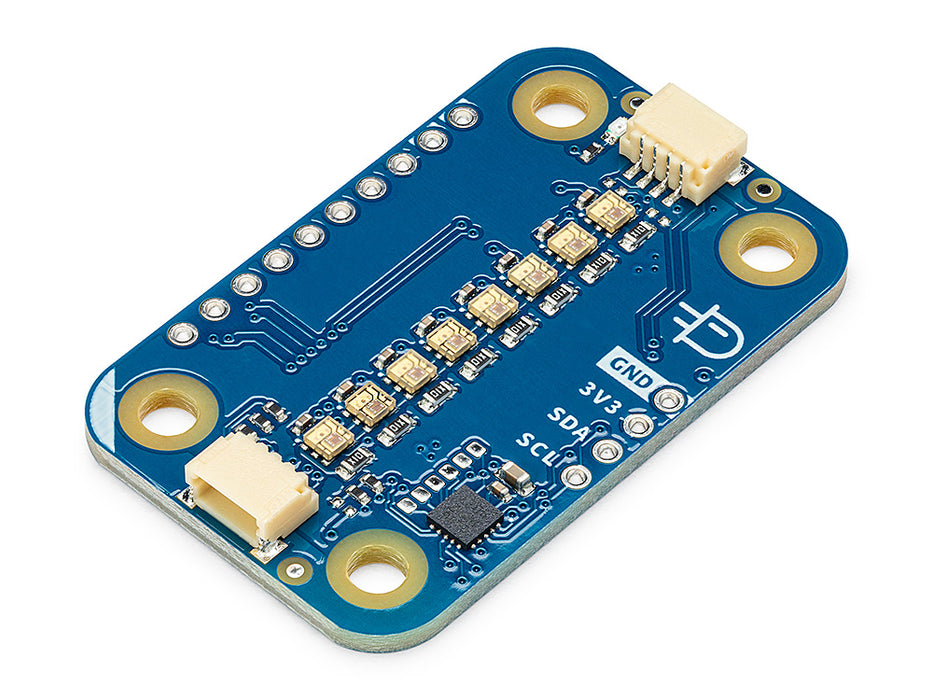
Overview
Modulino® Pixels is perfect to provide quick visual feedback and create simple effects and animations by regulating eight LEDs.
The Arduino Modulino® collection includes a variety of plug-and-play smart components that transform complex electronics into simple, interactive projects with minimal code and maximum creativity.
Discover a new generation of ready-to-use sensors and actuators that simplify any build. Designed for makers, educators, and professionals, Modulino® nodes connect effortlessly via Qwiic cables and work together as a unified system thanks to daisy-chain technology.
Start easy, advance quickly
Both beginners and experienced developers can implement sophisticated features thanks to preconfigured Arduino Cloud templates and a dedicated Modulino® library (supporting both Arduino language and MicroPython).
And after the first project is done? Consistent design across all Modulino® nodes gives you the flexibility to swap them and integrate them into a variety of new ideas, while breakout pins allow advanced users to push customization further.
Key benefits
- Plug-and-play connectivity:
Quickly connect Modulino® nodes to Arduino® UNO R4 WiFi or Nano boards, using the Nano Connector Carrier for fast, reliable integration. - Robust, ready-to-use design:
Preassembled, compact modules built to support demanding edge IoT projects. - Effortless expansion:
Easily add new sensors, actuators, or controllers without redesigning your hardware. - Seamless Arduino ecosystem integration:
Leverage Arduino software, Cloud tools, and community support to accelerate development.
Meet all the Modulino® nodes!
In addition to Modulino® Pixels, you can explore all the Modulino® nodes in the range!
- Modulino® Thermo: a sensor for both temperature and humidity data
- Modulino® Buzzer: to generate your own alarm sounds or simple tunes
- Modulino® Movement: to perfectly capture movements like pitch, roll or tilt
- Modulino® Knob: for super-fine value adjustments
- Modulino® Distance: a time-of-flight proximity sensor to measure distances with precision
- Modulino® Buttons: three buttons for quick project navigation
Or, consider the Arduino Plug and Make Kit to get them all at once – as part of our easiest starter kit ever!
Need help?
Comprehensive resources are available through dedicated documentation pages, featuring tutorials and technical specifications for each Modulino®.
Tech specs
| Board Name | Modulino® Pixels | |
| SKU | ABX00109 | |
| ECCN | 3A991.A.2 | |
| HTS | 85429000 | |
| Featured component | 8 addressable RGB LED (LC8822-2020) (STM32C011 for I2C communication) | |
| I2C Address | 0x6C (address can change via software) | |
| Connector | Qwiic | |
| Power | Qwiic connector | 3.3V |
| Pins | 3.3V | |
| Dimensions | Weight | 3.8 g |
| Width | 25.36 mm | |
| Length | 41 mm | |
| Accessories included | Qwiic cable (5 cm) | |
Conformities
Resources for Safety and Products
Manufacturer Information
The production information includes the address and related details of the product manufacturer.
Arduino S.r.l.
Via Andrea Appiani, 25
Monza, MB, IT, 20900
https://www.arduino.cc/
Responsible Person in the EU
An EU-based economic operator who ensures the product's compliance with the required regulations.
Arduino S.r.l.
Via Andrea Appiani, 25
Monza, MB, IT, 20900
Phone: +39 0113157477
Email: support@arduino.cc
Documentation
Learn more
Get Inspired
FAQs
Can I connect multiple Modulino Pixels nodes to a single Qwiic connector?
Absolutely! You can connect several Modulino Pixels nodes to the same Qwiic bus. To do this, you'll need to assign a unique I²C address to each Modulino node. The Modulino library includes an example sketch called AddressChanger that simplifies this process.
What can I control with Modulino Pixels?
You can individually set the color and brightness of each addressable LED by sending commands that specify the Red, Green, and Blue (RGB) color components, as well as the overall brightness level. This precise control allows for a wide spectrum of colors and dynamic lighting effects for each pixel.
Is a Qwiic cable included with the Modulino node?
Yes, each Modulino node is packaged with a 5 cm Qwiic cable, so you can get started right away.
Are the Modulino nodes compatible with other Qwiic devices?
Yes, the Modulino nodes are designed to be compatible with other devices that adhere to the Qwiic standard and operate at 3.3V. Always double-check the voltage compatibility of any Qwiic devices you intend to use together.
What voltage do the Modulino nodes operate at?
The Modulino nodes are designed to operate at 3.3V. Ensure that your microcontroller or other Qwiic devices provide this voltage level to avoid damage.
Do I need any special libraries to use the Modulino® nodes with Arduino?
Yes, you'll need to install the Modulino® library either for Arduino language or Micropython, which provides functions and examples to easily interact with the nodes.
Are there any example sketches available to help me get started?
Yes, the Modulino® library, for both Arduino code and micropython, includes several example sketches that demonstrate basic functionality. You can also use the Arduino Cloud templates to discover quick projects using the Modulino nodes.



